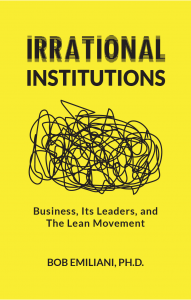This is the backstory to the book Irrational Institutions.

Irrational Institutions is a follow-on to my 2018 book, The Triumph of Classical Management Over Lean Management, which meticulously examined the problem of why leaders resist or reject Lean management. It succeeded at providing a comprehensive answer that readers find both accurate and convincing. Since finishing that book, I continued my studies and thought about other directions from which to understand this problem and find more answers. The ideas for another book came together in the fall of 2019 and involved examining other, somewhat obscure (but nonetheless important) aspects of business and leadership. The result is Irrational Institutions.
The term “institutions” as used in the book comes from the field of economics and means “social habits of thoughts and action.” This differs from the common use of the term “institutions” as organizations such as a company, and industry, or government. The title, Irrational Institutions, means “the social habits of thought and action that are irrational, common to individuals in a social group.”
The book examines the institution of business and the institution of leadership, as well as the Lean movement itself. Anyone with experience working in organizations and who carefully observes the top leaders cannot help but notice widespread habits of thought and action, particularly in relation to what is a problem and how problems should be solved. But, what is the purpose of these institutions, how do they function, who do they benefit, and why? Irrational Institution employs two new analytical methods:
- Critique of irrationality intrinsic to economics and the institutions of business and leadership
- Critique of aesthetic judgments of beauty and ugliness as determined by the institutions of business and leadership
The second method, aesthetics, is a unique way to examine irrationality, a new way to understand the problem at hand (why leaders resist or reject Lean management), and a new avenue to think about possible solutions. This second book also succeeds at answering the question of why leaders resist or reject Lean management in a concise yet surprisingly comprehensive way. Both The Triumph of Classical Management and Irrational Institutions cover different ground but are complementary to one another. They demystify and deconstruct leadership and expose what is really going on.
The two books also answer many more questions. One that on the minds of most top leaders these days is: How do I create an innovative culture? These books explain why that is so difficult to do and how most leaders will fail.
